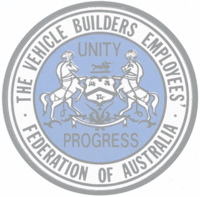Vehicle Builders' Employees' Federation of Australia
The Vehicle Builders' Employees' Federation of Australia (VBEF) was an Australian trade union which existed between 1863 and 1993. It was an industrial union which represented all production employees in the vehicle industry and automotive parts manufacturing industry.
 | |
| Full name | Vehicle Builders' Employees' Federation of Australia |
|---|---|
| Founded | 1863 |
| Date dissolved | 1993 |
| merged into | Australian Manufacturing Workers Union |
| Members | 52,000 (1976)[1] |
| Affiliation | ALP, ACTU, International Metalworkers' Federation, Workers' Educational Association[1] |
| Office location | 70 Drummond St, Carlton Victoria[1] |
| Country | Australia |
History
In the late nineteenth century a number of small unions were formed in the Australian colonies to represent skilled coachbuilders in the horse-drawn coach building industry. In NSW a union of coachbuilders was formed in Bathurst in 1863, while a South Australian union was formed in the 1880s, before folding in 1896 due to lack of members.[2]:251 In 1917 the Australian Coach, Motor Car, Tram Car, Waggon Builders, Wheelwrights' and Rolling Stock Makers' Employees' Federation was registered federally. During the 1920s the union's membership was transformed as motor cars replaced coaches and carriages, and assembly line methods of production replaced trade-qualified coachbuilders with unskilled or semi-skilled assembly workers. In 1930 it reregistered under the even more cumbersome name of the Australian Coach, Motor Car, Tram Car, Waggon Builders, Wheelwrights' and Air Craft Rolling Stock Makers' Employees’ Federation. In 1938 it changed its name to the much simpler Vehicle Builders Employees' Federation.
The union grew rapidly after WWII, due to the growth in the Australian car industry, reaching approximately 30,000 members by the early 1960s.[3]:42 Many of these new members were recent migrants from Europe, termed New Australians, who could easily find unskilled work in the large car assembly plants despite limited English. In 1993 the VBEF merged with the Metals and Engineering Workers Union to form the Automotive Metals & Engineering Union.
References
- Huntley, Pat (1980). Inside Australia's Top 100 Unions. Middle Cove, NSW: Ian Huntley (Aust.). pp. 305–308. ISBN 978-0-9598507-4-1.
- Wanna, Jay (John) (1984). The Politics of Organised Labour: An Analysis of South Australian Trade Unions in the Metal and Vehicle Industries (Ph.D.). Department of Politics, University of Adelaide. hdl:2440/21534.
- Bramble, Thomas (1 March 1993). "Trade Union Organization and Workplace Industrial Relations in the Vehicle Industry 1963 to 1991". Journal of Industrial Relations. 35 (1): 39–61. doi:10.1177/002218569303500103.